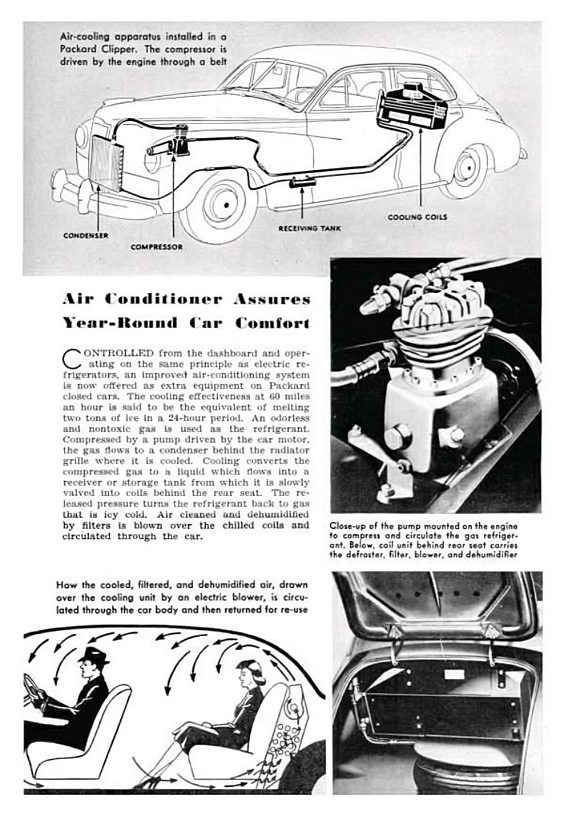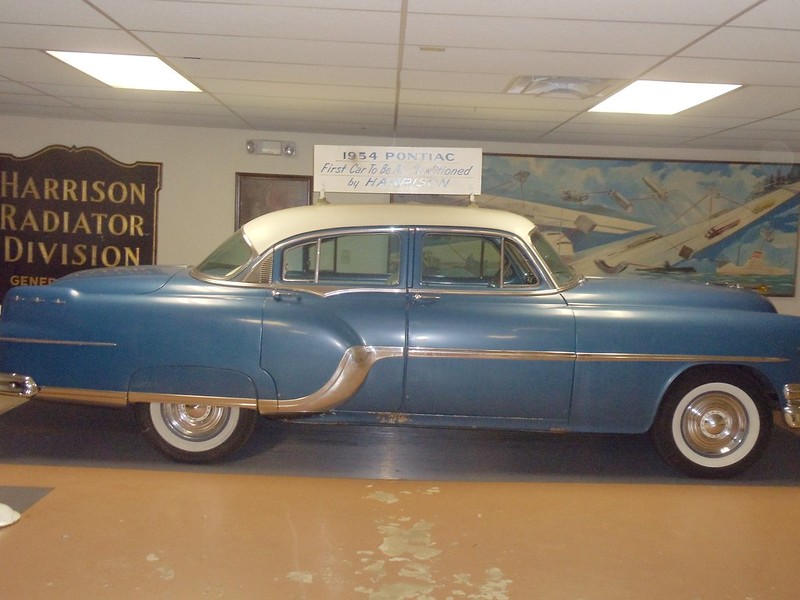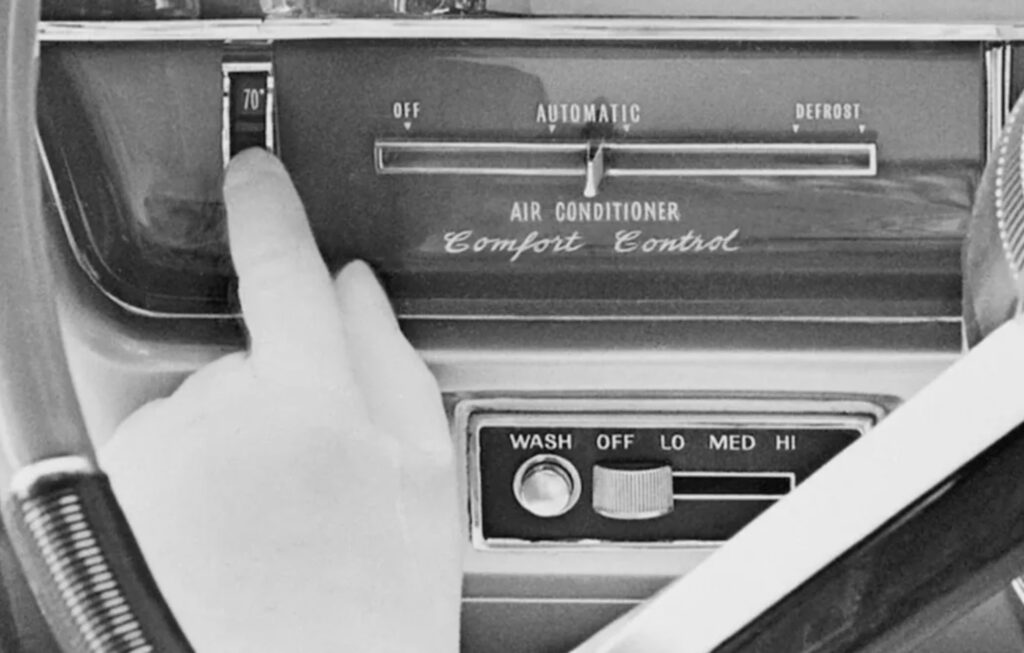
Once considered a luxury add-on, automotive air conditioning has come a long way in becoming a mainstay feature in vehicles today. However, the evolution of the auto automotive air conditioning system has been a long road. It had to endure world war II, technical challenges, and environmental concerns to get to where it is today.
Did you know: While air conditioners were invented in 1902, they took 37 years (1939) to make it into the first car and another 25 years (1964) to become a fine-tuned factory feature!
Today we will explore the invention of automobile AC units, when they originated, who invented them, and what car model was among the first to implement them into their design.
Tl;dr: Here's the timeline for the evolution of automotive Air Conditioning:
- 1935: Ralph Peo applied for the first Automobile air conditioning patent, which was granted in 1938.
- 1939: Packard Motor Car Co. was the first automaker to offer car air conditioning units as a luxury option. The bulky system was placed in the trunk rather dash of the car and costed $275 (about $5,830 in today’s money), a pretty penny back then and even today!
- 1954: Pontiac becomes the first car with front-mounted air conditioning units under the hood. ACs in the trunk were common until this point.
- 1954: Nash Ambassador was the first vehicle with a fully integrated front-end heating, cooling and ventilation system, setting a standard that is even followed today. The company called the system “All-Weather Eye”.
- 1964: The Cadillac introduced the ‘Comfort Control’, which allowed one to set the preferred temperature with a dial (similar to Auto climate control). It was one of the major breakthroughs, paving the way for modern automotive air conditioners.
- 1969: More than half of the cars (54%) sold in America had air conditioners.
- 1973: 70% of the cars sold in America came fitted with AC.
- 1987: Following Montreal protocol, Automakers were asked to phase out R-12 refrigerant and use R-134A gradually. Today automakers are switching to R-1234yf as it’s more eco-friendly.
- Today: 99% of the cars sold today have air conditioning systems.
Packard Motor Car Co. was the first car company to offer air conditioning in its cars in 1939
The first automobile air conditioning system patent was granted to Ralph Peo in 1938, but it wasn’t a production-ready design. The invention of automotive air conditioning is largely attributed to Packard Motor Car Co., an American luxury car company.
On Nov 4, 1939, the Packard introduced the Packard 1940 model, the first car with a factory-installed air conditioning/heating system. The air conditioning unit was manufactured and installed by Bishop and Babcock (B&B) in Ohio.
On March 17, 1940, the first air-conditioned taxi, a Packard 1940 model, was driven in New York.
From 1939 to 1942, the company sold just 1500 AC-equipped cars. However, in 1942, Packard discontinued the option as it wasn’t commercially viable, partly due to World War II efforts.

Early Problems
The Packard air conditioner was bulky, expensive, and had few reliability concerns. The refrigerant coils were placed in the trunk, which took up half the space; there was no way to regulate the temperate and worse, to stop the AC, one needed to remove the belt connected to the compressor. Further, the AC add-on was priced at $275 (roughly $5,830 in today’s money), which was quite steep for the time.
The 1950s saw aftermarket auto Air Conditioners become a big business
After the end of World War II, many independent companies began manufacturing and installing aftermarket air conditioners in cars. The Frigikar system was the most common aftermarket unit. By 1953, around 30,000 cars had these aftermarket AC units.
Sensing the pent-up demand for air conditioners, the battle between Automakers ensued to come up with an AC unit that was efficient, cheaper, and more reliable.
Closer to Perfection
In 1954, Pontiac became the first car with all the AC equipment housed under the car’s hood. Until this point, the AC units were placed in trunks. The system was developed Harrison radiator division of GM motors.
The same year, Nash Ambassador took the game a notch higher as it came with the first fully integrated heating, cooling and ventilation system. Before this, automakers used separate chilling and heating units.

The final piece of the puzzle: Automatic Climate Control
The major breakthrough came in 1964 when General Motors introduced ‘Comfort Control’ in the Cadillac. The system maintained the set temperate in all climate and engine operating conditions, similar to today’s auto climate control.
In 1967, GM’s Frigidaire Division developed the ‘air-mix’ system, which increased the air conditioner’s efficiency and made it more affordable.

The early 1970s was when air conditioning became common in cars.
Owing to the technological enhancement and volume of scale manufacturing, in the early 1970s, air conditioning systems became affordable, becoming a common feature in cars.
By 1965, about 25% of the cars sold in America had air conditioning. The number rose to 54% in 1969, and by 1973, it was close to 70%. Today, 99% of the cars sold have an air-conditioning system.
Turning point: In 1968, AMC Ambassador became the first car to come with air conditioning as a standard feature. Until this point, air-conditioning was only available as an option and it changed the AC-game forever.
The 1980s: The Environmental Impact becomes apparent
Due to the chlorine content, the R-12 refrigerant used in the car AC was found to have a damaging effect on the ozone layer. The rising environmental concerns led to the Montreal Protocol in 1987, which requested manufacturers and automakers to phase out R-12 refrigerants gradually.
By 1994, automakers switched to R-134a, a more environment-friendly refrigerant. However, in the early 2000’s it was found that the R-134a had a very high global warming potential (GWP). The GWP number of R-134a is 1430, which is astronomically high and for this reason, it’s also getting phased out.
In the present day, automakers are switching to R-1234yf, which has a GWP of just 4. A very small number compared to the R-134a refrigerant.
The Takeaway
Thanks to Air conditioning, we now experience the road differently. So whenever you turn on the AC in your car on hot summer afternoons, don’t forget to be grateful to the engineers and automakers who have made this possible.
It is indeed incredible to look back and see how far the air conditioning system has come in automobiles, from being a bulky aftermarket accessory selling to now being standard in 99% of the cars sold today.
Sources:
- https://www.epa.gov/mvac/refrigerant-transition-environmental-impacts
- https://www.jstor.org/stable/44553839
- https://patents.google.com/patent/US2237497A/en
- https://www.hagerty.com/media/maintenance-and-tech/air-conditioning/
- https://www.newspapers.com/clip/18028025/1954-pontiac-with-ac-first-year/
